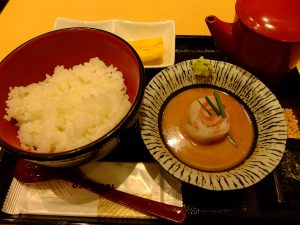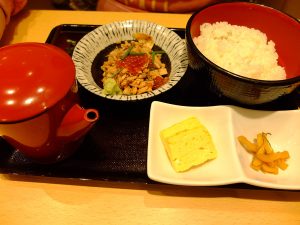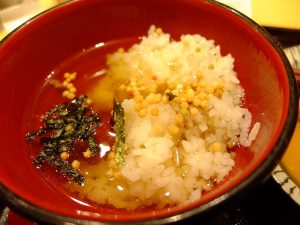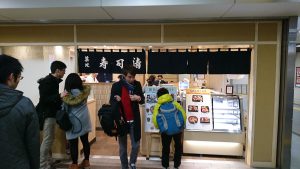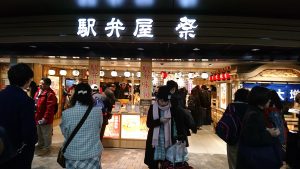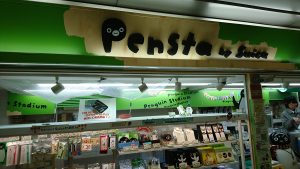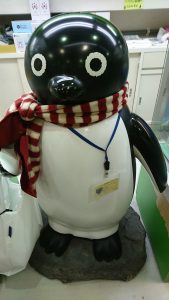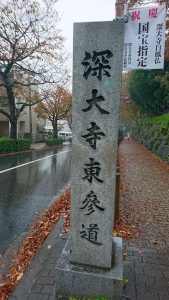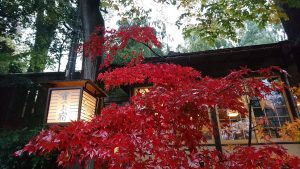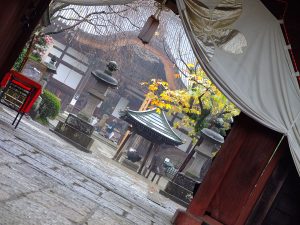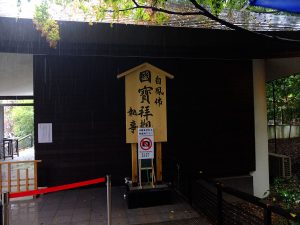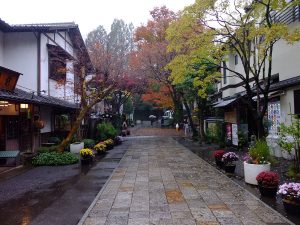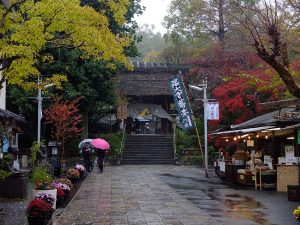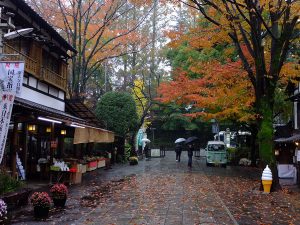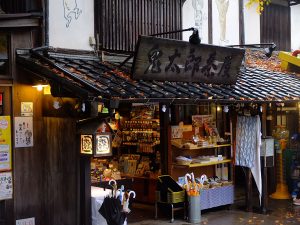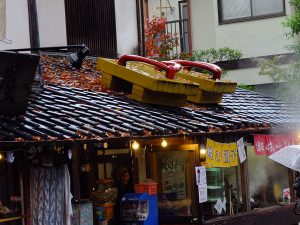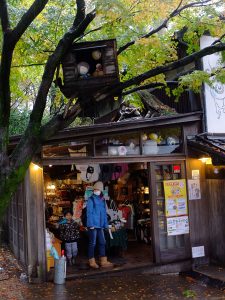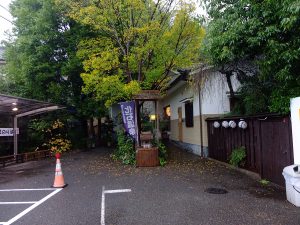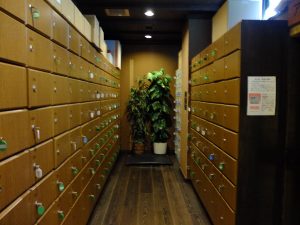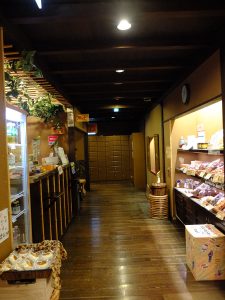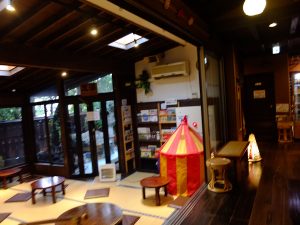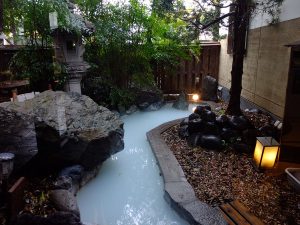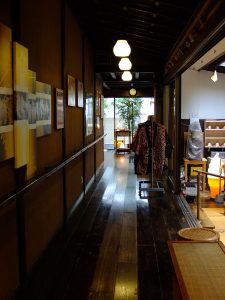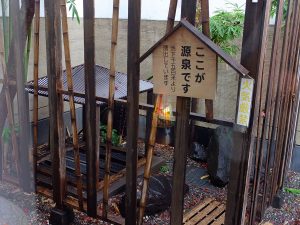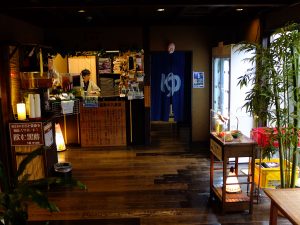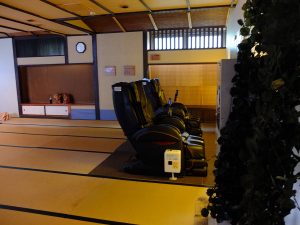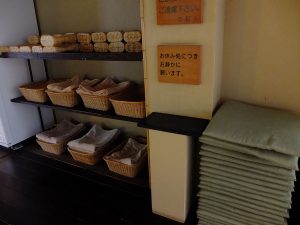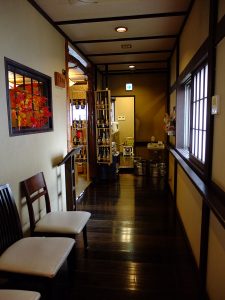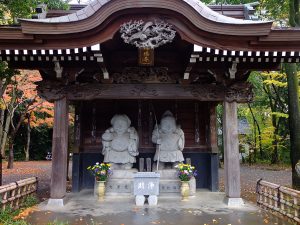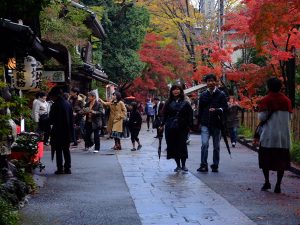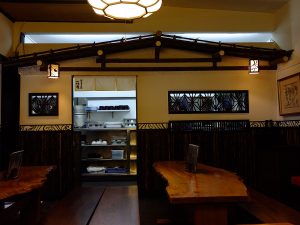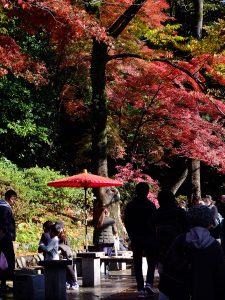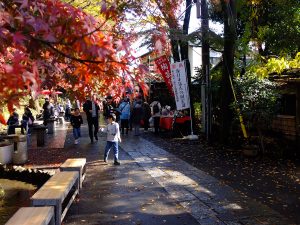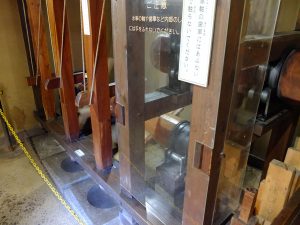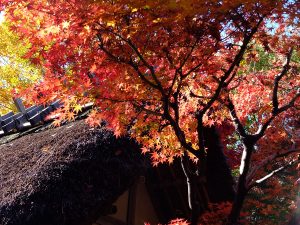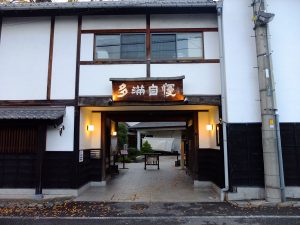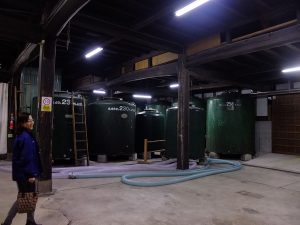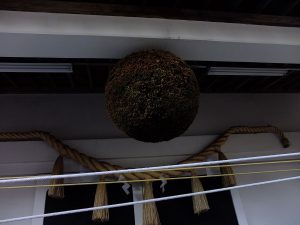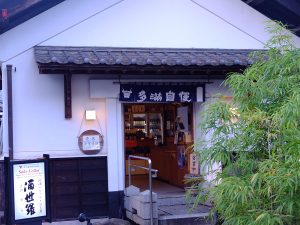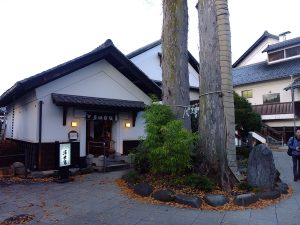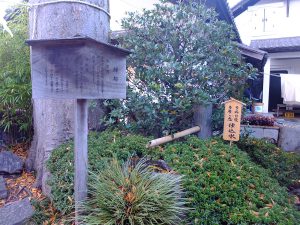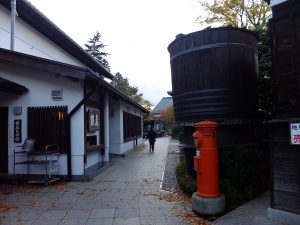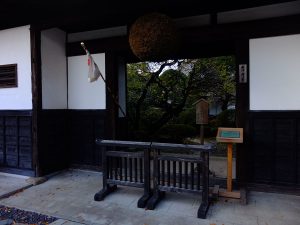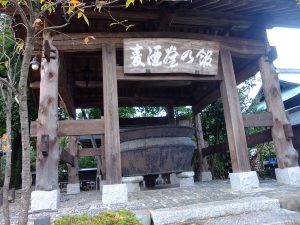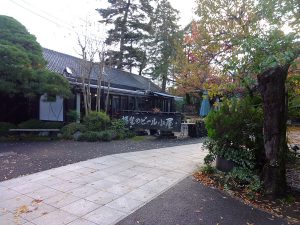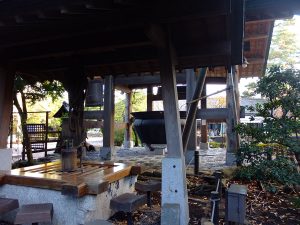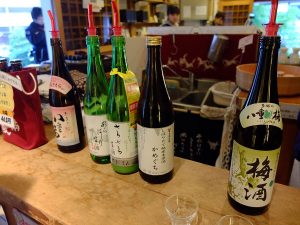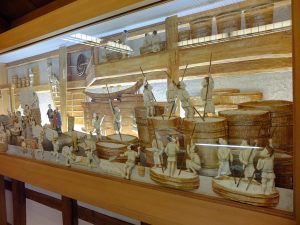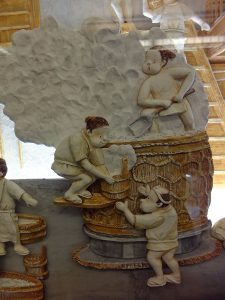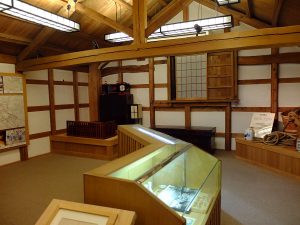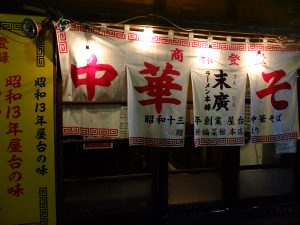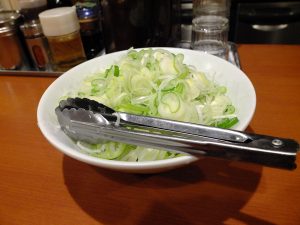Buzzing sounds at 4:35am. It’s the alarm.
清晨4.35嗡嗡作響。是鬧鐘。
I leapt out of bed and quickly got changed.
我跳起床連忙換上外衣。
The first monorail leaves at 4:59am.
單軌電車首發4.59。
Hamamatsucho station where the monorail terminates on the Tokyo end is just 800m from the hotel. This was one of the major considerations in choosing the location, to catch the very first train to Haneda Airport.
單軌電車東京側終點的浜松町站離旅館只有800公尺。這是選這地點的一大理由,好搭第一班車去羽田機場。
There was a lot of traffic given the hour, the sky was still dark and darker still with the light drizzle. I got to the station with several minutes to spare, already there were many people lined up outside the ticket gate with large luggages with them also wanting to get to the airport as early as possible.
這時間來說街上的車挺多的,天還黑的,薄薄細雨下更顯昏暗。到車站時離發車還有幾分鐘,閘門外已經有許多人帶著大箱小箱等著趕去機場。
Y had landed early and had already passed customs. I sent a message to find some place or cafe to rest first.
Y 提早降落已經過海關了。我傳短訊請說先找個地方還是咖啡店休息一下。
The first train was an rapid service, took just 13 minutes to get to Haneda.
第一班是快車,只13分鐘就到羽田。
We met up outside the Lawson store, I also got a rice ball to tie me over till breakfast opens, and we headed to the Keikyu gates to go to Shinbashi.
到了後在Lawson碰面,我順便買了個飯糰不然撐不到早餐時間,接著去京急搭車去新橋。
There was a lot of people waiting to top up at the Keikyu machines so I took Y’s card and ran to the monorail side just on the other side of the terminal hall and topped up there.
有很多人再京急外等著買票儲值,我靈機一動拿Y的卡到車站大廳另一側單軌電車外儲值。
Unfortunately we still missed the train, thankfully only had to wait 15 minutes for the next one.
但還是沒能趕上車,下一班等15分鐘還算好。
The Keikyu line connected to the Asakusa metro, the train goes directly to Shinbashi in about 25 minutes. It had begun to rain moderately. We walked to Super Hotel, threw the luggages into my room for now and went back to Shinbashi station.
京急線與地鐵淺草線有直通,坐車直達新橋大約25分鐘。雨變大了。我們走到Super Hotel先把行李丟我房間,然後回到新橋站。
The rain did not look to be stopping anytime soon, I decided to shift the original plan of going to Meiji Jingu Outer Garden then breakfast at Shinjuku to the backup.
雨看來一時不會停,於是我把原本要去明治神宮外苑然新宿吃早餐的計畫移掉,改去備用行程。
Tokyo station first for breakfast, then Shinjuku and arrive early at Jindaiji temple.
先去東京車站吃早餐,再經新宿早點到深大寺。
Tsukiji Sushi Sei at Gransta (the shopping street beneath Tokyo station inside the ticket area) opened at 7am.
Somehow despite missing the earlier train back at the airport, we were still a few minutes early and first waited by the Silver Bell.
Gransta(東京站閘門內地下街)的築地壽司清7am開。
即便稍早在機場錯過了班車,到東京站時依然早了幾分鐘,只好在銀鈴旁等了一下。
This was the first proper meal I had planned to eat and actually ate since arriving in Japan, I commented.
這是我這次到日本第一餐有計畫且順利好好吃到的一餐,我說道。
We were the first one there, more people soon came and a line quickly formed behind us. It’s a holiday, I thought. The restaurant opened, we were asked to order first so I ordered the tai fish in sesame sauce and Y the grilled fish and fish egg then we were shown to a table. The was not very big, maybe 6 tables and a row of counter seats.
我們是第一組客人,很快人越來越多,後頭很快排了一排。今天是國定假日不是。店開了,店員請我們先點餐,於是我點了芝麻醬鯛魚,Y則點了烤鮭魚和魚卵,然後被帶到座位。店不大,大概只有6張桌子和6個吧台座位。
By the time our food arrived the place was full. And today was a holiday, imagine on a work day.
當餐點送來時就坐滿了。今天還是假日,若是上班日還得了。
The set included the main dish, rice, pickles, eggroll, some seasoning and a small pot of soup. We were wondering what the pot was for before we found the instructions on the paper stand. The soup was meant to be poured into the rice bowl, it was recommended that this be done after half the rice had been eaten to enjoy a different rice experience.
That made sense.
餐點包含主餐,白飯,醬菜,蛋捲,一些作料和一小壺湯。一開始我們還在想這壺湯要怎麼喝,後來才在桌上立的紙板上找到說明。湯是直接倒飯碗裡的,建議飯吃了一半後在加,可享受兩種不同的味道。
原來如此。
The fish was delicious if the portions a little small. The soup with rice was perfect on a cold morning, very light and gentle with a subtle flavour.
魚很好吃,份量少了一點。湯泡飯在寒冷的早上堪稱完滿,很清淡溫和的味道。
We did not sit for too long after finishing our meal, there were many people waiting outside.
吃完不好意思多坐,外頭等的人很多。
The plan was to wait until 8am when Pensta opens. Maybe because it’s a public holiday or my memory had failed me, shops only begun to open at 7:30 and even then most shops not until 8. We ended up wandering at random, checking out the bento stalls and sweets shops.
計畫是晃到8點等Pensta開。或許是假日或是我記錯了,一直到7.30才有一些店開門,而大多店要到8點。我們只好隨便亂晃,看看便當和糕點店。
Tokyo station sure have a lot of bentos. And Tokyo Banana seemingly have a stall at every corner and turn.
東京車站的便當有夠多種。而東京香蕉似乎每個轉角都有一家。
JR East’s suica IC cards have a penguin on them as mascot, Pensta is a store selling goods associated with the fluffy creature.
Cards, pens, mobile cases, pass cases, water bottles, even tooth brushes. There were also cookies and sweets. Small the shop may be, it held plenty curiosities.
JR東日本的西瓜卡上有隻企鵝吉祥物,Pensta就是專門賣這隻毛茸茸生物的周邊商品。
卡牌,筆,手機殼,IC卡袋,水壺,甚至牙刷。還有餅乾糖果。店不大,奇妙的東西可不少。
Planned for first half of the day is Jindaiji and the Yumorinosato onsen nearby.
第一天早上的主軸是深大寺和附近的湯守之里溫泉。
Jindaiji is about 30 minutes west of Shinjuku, a few km below Mitaka. It’s not a super popular spot because of its distance from train stations makes it not very accessible comparatively.
深大寺大約在新宿往西30分鐘,三鷹下方幾公里。由於離車站有點距離相對下交通不很方便,不是說太有名的景點。
I ran across the location because I had already penciled in the sake brewery tour which is at Haijima on the far western side of Tokyo and wanted to find a place for Y to have some rest after the red eye flight.
會找到這地點是因為一開始就已經確認要去的酒造在東京最西側的拜島,同時又想要找個地方給Y在紅眼班機後休息。
I basically looked at every onsen, spa between Tokyo and Tachikawa. There’s LaQua at Tokyo Dome, Oedo Monogatari of course, there’s also Niwa no Yu at Toshima, several onsen baths in Kamata district, Akishima Onsen which is close but still some distance to Haijima.
差不多翻遍了東京到立川間所有的溫泉和澡堂。有東京巨蛋的LaQua,想當然的大江戶溫泉物語,豊島的庭之湯,蒲田的幾個溫泉,離拜島比較近但還是有段距離的昭島溫泉。
Yumorinosato was chosen due to it being next to Jindaiji, a nice place to visit and still more or less along the chuo line axis to be considered on the way, and just about the right distance that arrival there won’t be too early nor late.
選湯守之里是因為靠近深大寺,算不錯的景點,又還算在中央線軸上不算太繞路,距離又剛剛好不會到的時候太早或太晚。
There’s a small detour during the transfer at Shinjuku to check out the penguin statue outside the southern exit.
在新宿時稍微繞了一下去南口的企鵝廣場看企鵝雕像。
There’s a few ways to get to Jindaij, either Mitaka from the north or Choufu from the south. Mitaka is faster by Chuo line from Shinjuku but has a longer bus ride. Choufu on the Keio line is slower but much closer by bus. In general, going via Choufu is faster all things considered.
到深大寺的方法有幾個,從北邊的三鷹或南邊的調布。從新宿到三鷹有中央線快速比較快但巴士路程較遠。調布是搭京王線比較慢但巴士比較近。考慮全部車程一般來說從調布會比較快。
We checked the map for the Keio line station at Shinjuku, it was as confusing as ever. Thankfully the flight of stairs we decide to go down was the correct one.
我們在地圖上找新宿的京王線車站,照樣是一頭霧水。幸好後來決定轉下去的樓梯是對的。
It was still raining by the time we reached Choufu, the forecast said it would stop by lunchtime but looking at the skies that seemed unlikely.
到調布時依然在下雨,天氣預報說中午就會停但看這天空實在是不樂觀。
The bus stop to Jindaiji is on opposite corner of the loop coming out the surprisingly new and fancy station. The bus waiting there was the one we wanted.
往深大寺的巴士站牌在意外新穎的車站外的圓環對側。停著的巴士正好是我們要的路線。
Does this go to Jindaiji? I asked.
No no, the driver answered.
有到深大寺嗎?我問道。
沒有,沒有到,駕駛回答道。
I stepped back and check the route number. It’s the right one, then I realized the driver must be pedantic.
我退了幾步看了看路線號碼。沒有錯啊。我突然想到駕駛一定是想太死了。
Jindaiji primary school? I asked again.
Primary school is fine. The driver replied.
深大寺小學?我改問道。
小學的話OK,駕駛這次說道。
The two stops were less than a hundred metres apart. The primary school stop is at the intersection while Jindaiji stop proper goes into the street and is right before the temple. There’s practically no difference for someone going to Jindaiji.
兩個車站相差不到100公尺。小學站牌在路口而真正的深大寺站牌在轉入街道佛寺正門前。對要去深大寺的人實際上沒有差。
A quick 10 minute bus ride and we got off at the start of the Jindaiji main street.
坐巴士10分鐘後再深大寺大街路口下。
Jindaiji is Tokyo’s second oldest temple. Sandwiched between the ruins of Jindaiji castle and a botanical garden the temple and surrounding area escaped modern encroachment and retained much of the traditional feel of the Edo era. The area is blessed with many natural springs and several streams flows through the area.
深大寺是東京第二古老的佛寺。夾在深大寺城蹟和植物園間,佛寺和周遭逃過了被現代化的命運,現在還保有江戶時代氣息。這一代又有許多天然湧泉,有無數條小溪流過。
Raindrops from heaven spattered on the stone paths. Pilgrims heading for worship on the timeless road.
雨打在石板路上。在見證歲月的小徑上走著去祭拜的信徒。
The main thatched gate is covered in moss, it has stood here for over 300 years, the oldest structure in Jindaiji.
佛寺草紮大門上滿是苔癬,樹立在這已有300年,是深大寺最老的建築。
There was a small girl in formal kimono dress worshipping inside the main hall with her parent. It’s unclear whether today was actually a day with special meaning in Japanese tradition since we later saw another girl also in formal dress. Maybe some kind of growing up ceremony?
佛寺寶殿裡內有位穿傳統和服的小女孩跟她雙親在進行儀式。不確定今天是不是有什麼節日,後來也有看到另一個傳統穿著的小女孩。某種小孩長大的祈福儀式?
Jindaiji is home to a national treasure, a copper buddha statue from the late Asuka period sometime in the 7th century, one of the oldest in Kantou. The statue used to be gold plated but the gold was lost in a fire.
深大寺藏有一國寶,一尊後飛鳥時代,大約7世紀的如來佛銅像,關東最古老的銅像之一。銅像原本有鍍金但在一次大火中毀損掉了。
It was housed in its own special display room which guests were allowed to view through the window. A monk standing on duty helpfully handed us Chinese pamphlets.
佛像擺在專用的展示間內,遊客只能從外面透過玻璃參拜。一位輪班的僧人熱心的拿了中文解說給我們。
It was past 10, meaning it was time to head to the onsen.
過10點,可以去溫泉了。
Yumorinosato was about 5 minutes walk south of Jindaiji. Much like Jindaiji it retained much of the old traditional bath atmosphere.
湯守之里在深大寺往南走5分鐘處。跟深大寺一樣的保有傳統溫泉湯屋的氣息。
Upon entering one is to remove thier shoes and put it into a shoe locker on the left, then take the shoe locker key to the front desk where one choose the desired plan.
入門後第一件事是拖鞋,拿到左側的鞋櫃收好,鞋櫃鑰匙再拿到櫃檯然後選想要的泡湯方案。
Today was a holiday so it was 1200Y for unlimited time with provided towels (on weekday it’ll also include a yukata). The front desk took away the shoe locker key and gave us a numbered locker key and a towel voucher. Any purchases made in the bathhouse is charged to the number and the total paid at the end when checking out.
今天是假日所以不限時1200Y,有附毛巾(平日多附浴衣)。櫃檯會把鞋櫃鑰匙收走,給另一個有號碼的置物櫃鑰匙和一張毛巾卷。在湯屋內的花費都直接報號碼,離開時再結帳。
The place was old but quite cozy. It went through a change of management a few years ago and it looked like the new owner brought in new decorations like the suit of armor and potted plants, hung arts.
當屋很老不過很舒適的感覺。前幾年換過經營者,新的老闆看來有重新整理過,添置了許多例如盔甲,盆栽,畫。
The interior could be broken into a few areas. Near the front desk was a little shop area where one could buy beauty products and some traditional Japanese souvenirs, the selection indicates the place sees quite a few foreigners. A long corridor goes all the way through the building, midway down the corridor there’s a reading area where juice and other drinks are also sold, outside the reading area is a foot onsen. At the end the corridor opens up into a foyer area where the bath entrance is and the stairs to the second floor, outside the foyer is a small garden where the source well of the onsen water is.
裡頭可分幾個區域。櫃檯一側是個販賣部賣美容化妝品和一些日本風格的紀念品,看商品走向這裡應該有不少外國客光顧。一個長廊貫通建築,在半途的讀書休息區也賣果汁之類飲料,外頭則是足湯。在長廊底端是個門廳連結浴場的入口和上二樓的階梯。門廳外是的小院子,溫泉源泉井就在這。
Between the bath entrances there’s a counter where one exchanges the voucher for towels then head on through to the changing rooms. The change room is huge with rows of lockers. I put my things into the locker and head on into the bath.
澡堂入口間有個櫃檯,在這用毛巾卷換毛巾,進去後就是更衣室。更衣室沿著牆全是置物櫃。我把背包和衣服鎖入櫃子,進去澡堂。
The onsen water here is drawn from over 1500m below. Much like many onsens in Tokyo the water is blackish (Tokyo use to be a swamp), one could not see one’s hand when dipped in just 5 cm deep.
這裡的溫泉水是從地底下1500m抽出的。與東京許多溫泉一樣水成黑色(東京過去是沼澤),水中5cm就深不見手。
The water is at a much more comfortable temperature than the ones in Kusatsu. I first settle into the indoor bath to warm myself before trying the outdoor ones.
水溫比草津的舒服多了。現在室內溫泉泡暖暖身再去露天吧。
The place is curious in its large variety of baths and use of feng shui. Some of the outdoor baths have the name of the 4 mythical beasts carved in them, said to improve the onsen’s healing powers.
這裡不知為何溫泉池數量很多,還有配上風水。露天池中寫有四神獸,說是能增加溫泉效益。
The onsen was surrounded by thick forests and one could hardly believe this was in the middle of Tokyo.
溫泉四周圍繞著樹林,很難想像這是在的東京都會中。
Waking up before 5 this morning was quite rough, a hot onsen was much needed.
早上5點前就起來還真是夠嗆的,我也正好泡泡休息一下。
After the bath I did a walk around, taking photos. Y had not come out yet so left a message and went upstairs where the restaurant and sleeping quarter is. The sleeping quarter is a large tatami space, maybe about 6 by 6 metres, where people could lie down to rest. Wicker weave pillow and cushions are stacked on the side for one to use as needed.
泡完溫泉我隨處晃了晃,拍拍照。Y還沒出來,我留了短訊,上去有餐廳和睡覺間的二樓。睡覺間是鋪設榻榻米的大房間,大概有6x6m,可以隨意找地方躺下休息。房間一側堆疊了藤編枕頭和墊子可自己拿來用。
Turned out Y came out not long after me but missed the message on Line. Ended up staying at the onsen a little longer than planned.
結果Y其實已經出來了不過沒看到我留的Line。結果在溫泉待了比計畫的久一點。
Feeling refreshed, we went back to Jindaiji for lunch. The rain had stopped just as forecasted, impressive.
休息過精神飽滿,回深大寺吃午餐。天空真如預報的放晴了,太神了。
In times past the area was more suited for growing buckwheat than rice and soba noodle became associated with the area. The soba here was presented to the shogun on hunting trips and received much praise.
過去這地區不適合種稻,適合種蕎麥,於是蕎麥麵成了這地方的特色。這裡的蕎麥麵曾上供給來此打獵的將軍,受到讚賞。
There are some 20 odd soba restaurants around Jindaiji and competition is fierce. I had written down 3-4 ones that people have said were good and figured we’d see whichever one we run into first. That turned out to be Ikkyuan.
深大寺附近有20多家蕎麥麵餐廳,可謂一級戰區。我記下了3-4家網上說不錯的,想看先遇到哪家就吃哪家。看到的第一家是一休庵。
The place was down to earth like a common eatery, there are regular tables and also tatami rooms for larger groups. The workshop where they make their soba is right by the entrance as one walks in.
店內挺樸素的,跟一般食堂差不多,有一班桌椅也有團體坐的榻榻米間。製麵的工房就在入口龐可看他們現做。
The place was not very busy yet and we sat down at a long wooden table.
店裡還沒有很多客人。我們隨便在一張長木桌坐下。
The menu is somewhat confusing. There are 3 groups of soba noodles: 100%, 90% and 80%. We worked out this meant what percentage of flour the noodle is made of is buckwheat. 100% means all buckwheat, 90% means 10% is wheat flour.
菜單有點複雜。有三種蕎麥麵:十割,九割,八割。我們猜想這是蕎麥粉比例,十割就是全蕎麥粉,九割則是有混入一成的一般麵粉。
We both go the 90% one. Y commented later maybe we should have each ordered a different ratio to see what was the difference.
我們兩都點了九割的麵。Y說其實我們應該各點不同比例的吃吃看差異。
The soba was served on a wicker plate together with a bowl of sauce, a bit of wasabi and spring onions and a pot of something soupy. I asked the staff what the soupy thing was and she explained it was soba-yu, or the water used to cook the soba. After one has finished the soba one should pour the soba-yu into what’s left of the sauce to create a soup that can be enjoyed.
送來的蕎麥麵擺在藤盤上,另外附一碗醬汁,一點芥末,蔥,還有一壺像是湯的東西。我問了店員這壺湯是什麼,得到這是蕎麥湯,也就是煮蕎麥的水。吃完麵後可以把蕎麥湯倒入醬汁中做成熱湯喝。
The soba was much firmer and textured than other soba I’ve had before in Japan, can’t decide whether that’s good or not. Y seemed to like it, so that’s good.
蕎麥麵比在日本其他地方吃過的有勁有質感,說不上比較好還是壞。至少Y覺得不錯就好。
The crowd was out in force now, the streets before the temple packed with visitors.
人群湧出了,佛寺前的表參道滿是遊客。
There were a few shops around Jindaiji. Some sold sweets, grilled rice cakes. There’s a craft shop where people could paint or make their own pottery.
深大寺附近有不少商家。有的賣甜點,烤麵餅之類。有一家陶藝店遊客可自己幫陶瓷上漆或自己捏製陶器。
There’s a Kitaro cafe/shop based on the manga about Japanese ghosts and monsters. On the roof of the cafe is a pair of giant geta, the walls painted with adorable monsters that appeared in the manga. On a tree outside there’s a treehouse where Kitaro is seen playing with his friends.
這裡有一家鬼太郎茶屋。屋上有一雙巨大的木屐,牆上畫有漫畫中出現的各式可愛鬼怪。外頭樹上有個樹屋,鬼太郎跟朋友們在裡頭玩。
We probably needed another half hour, the area was much more interesting than anticipated. Unfortunately time was pressing, we still had to get to the sake brewery before 2:30pm.
意外的好逛,要好好看完大概還需要半小時。但是時間不等人,跟酒造約好了2.30前必須到。
We just missed the bus going to Mitaka. Admitted we didn’t so much as miss it but I thought we didn’t have to run for it because google map told me the bus wasn’t due to leave for another 5 minutes. Sadly google map didn’t know today was a holiday and bus ran on different times….
我們剛剛好錯過了去三鷹的巴士。嚴格說我們可以趕上的,但是google map說還有5分鐘所以我以為還不需用跑的。問題是google map不知道今天是假日,班次時間不同…
The next one was not due for another 15 minutes. Connecting at Mitaka was going to be a bit too close to get to Haijima on time, there did not seem to be other faster alternatives.
下一班要等15分鐘。在三鷹轉去拜島有點緊湊,但似乎也沒有別的方法。
I shrugged it off for the time being and suggested we check out a watermill nearby till the next bus.
暫時先不去擔心了,我建議在下一班車前去附近的水車看看。
The watermill is just about 10 metres up the road. This is a still working actual watermill which can still used today to mill grains (have to fill in a form beforehand to apply for a time slot). Located next to the watermill is a small museum displaying the traditional tools used for farming back in the days.
水車離公車站就10公尺。這個水車是還有在實際運作的,現在都還可以用來磨穀類(需要填表格申請時段)。在水車旁是個小博物館陳列古時候耕田使用的器具。
We departed for Mitaka. Luck was not with us that day, the bus got into a little bit of traffic and we missed the connection entirely at Mitaka. Now we were in trouble.
我們往三鷹出發了。運氣不好,有點塞車在三鷹完全沒趕上電車。現在慘了。
We caught the next available train. I sent an email to the brewery that we would be about 20 minutes late. I was biting my lips, hope they won’t cancel our tour.
我們搭上下一班車,然後我記了封信給酒造說我們大概會慢20分鐘。我擔心地咬著嘴唇,希望他們不會取消導覽。
Haijima is on the western outskirts of Tokyo, on the border of what might be called rural Tokyo bounded by the Tama river. Across the river laid the Western Tama region where rice paddies and forested mountains could be found.
拜島在東京西邊郊區,在以多摩川為分界的東京鄉村地帶邊緣。河川另一岸就是西多摩地區,有田園和青綠山脈。
Situated at the foot of the mountains this area is blessed with good spring water and has a long tradition of sake brewing since ancient times.
位在山腳下的這地區於是擁有相當好的泉水源,從古時候就有釀酒的傳統。
But there was no time to take in the scenery. Originally I had planned to walk the 1km distance to the brewery, now that we were late, I suggested we take a taxi instead. We got to the brewery about 20minutes later than the reserved time, I introduced myself to one of the staff and to my relief she just said welcome and called for our guide.
現在沒時間欣賞風景。原本是想走1km到酒造的,現在已經遲到於是我建議搭計程車。到酒造時比預約的時間晚了20分鐘,我上前跟一名員工報了名字。讓我放心的,員工只是歡迎我們後就去叫我們的導遊。
The brewery is called Ishikawa Brewery, one of around 6 brewery in Tokyo that offered tours and one of 2 that offered them in English.
酒造叫石川酒造,東京都內大約6個有開放導覽的酒造中有提供英文導覽的兩家之一。
Finding brewery tours took significant effort during planning.
在規劃時找酒造導覽花了不少功夫。
Originally I had tried to look for tours by well known brands, however their factories were a prefecture or two out, or even in Kansai. Then looking at the individual breweries within Tokyo itself, many of them had already modernized and were brewing in concrete factory like buildings, which loses much of the charm of visiting a sake brewery.
原本是想找出名大廠個釀酒場,但他們的工廠大多在別的縣,有的在關西。然後在找東京內的個體酒造時大多都已經現代化了,是在水泥建築的廠房內釀造,這樣去參觀就少了一點趣味。
The choices narrowed down to Ishikawa and Ozawa, both breweries with very long histories.
最後篩選下有兩個選擇,石川和小澤,兩者皆是歷史悠久的酒造。
Ozawa is further west deeper into the Tama mountains. Founded in 1702 it retained its traditional storehouses and its tour includes seeing the natural mountain spring that the brewery takes its water from, within a cave 140m deep. It overlooks the nearby mountain river and there’s also a sake museum, a garden and tofu and craft shops, forming its own tourist spot.
小澤酒造在更西邊多摩山區內。創立於1702年,保有傳統藏屋,導覽還包括去看他們取水的地方,一個140m山洞內的山泉水。酒造本身在山中小河岸上,有個清酒博物館,花園和豆腐傳統工藝店家,獨自形成的觀光景點。
The two downsides are it only offered English pamphlet, the tour is still in Japanese. And that it’s another 40 minutes by train from Haijima. Going there requires dedicating the whole day.
但有兩個缺點,一是他只有英文的傳單,導覽還是講日文。另外是從拜島還要40分鐘車程,若去的話需要一整天。
Ishikawa isn’t as scenic as Ozawa, but offered just as much if not more in other areas.
石川沒有小澤酒造的優美環境,但其他處有他更多的特色。
Our guide turned out to the the company director’s assistant. A middle aged woman with quite good English. She was friendly though reserved, perhaps because of having to speak in English she tried to stay to her notes.
我們的導遊是酒造總經理的秘書。一個英文說的不錯的中年婦人。算友善但有點很熱誠,可能是說英文的緣故她大部分是按照筆記講解。
Our tour begins with the main storehouse, built in 1880 and a registered tangible cultural properties. The storehouse is 3 storey tall and about 25m by 28m at its base. The earthern walls and doors are maybe 30cm thick, built to be fireproof to protect its contents in an age where fires often ravaged Japanese wooden houses.
導覽從主藏房開始。建於1880年,是國家登記有形文化財產。有三層樓高,長25m寬28m。土牆和門看有30cm厚,有很好的防火能力,在木造房子常引來祝融肆虐的年代,這對保護收藏的東西相當重要。
The inside is cool and spacious. Around the sides laid several large tanks where sake is brewed, the second floor and up might be used to access the vats but otherwise did not look to have things stored up there. The beams and pillars and most of the rest of the wooden structure are the original wood, our guide noted. The brewery is a small one and they don’t make much sake each year, though they are slowly expanding.
裡頭很寬闊涼爽。四周擺了許多巨大的釀酒桶,二樓以上可能用來爬至桶子上方操作,不然看起來沒有收藏東西。大樑,柱子和大多的木頭結構都是原本建造時的木頭,導遊說道。酒造不大每年製造的酒有限,但他們正慢慢努力擴展產量。
Our guide explained the process of sake brewing to us, some of which I had some vague idea before, others she made much clearer. I had always thought sake just used koji and did not realize koji is only used to turn starch into sugar, yeast still have to be added to turn the sugar into alcohol.
導遊解說了釀酒的過程,一些我本來就有概念,一些透過她的解釋比較弄得清楚了。我一直以為清酒就只是用麴,沒想到過麴是用來把澱粉轉為糖,還需要在加酵母才能把糖轉為酒精。
Coming out the storehouse, she then pointed to the cedar ball hung above the door and asked us if we knew what it was. I had some general idea that it signalled that the new batch of sake is available. Turned out the ball meant much more. The cedar ball or sugidama is built fresh each year so that a cedar ball that’s just been hung out would be slightly green. Overtime the cedar ball would turn brown and this allowed people to know from a glance how long ago the sake was brewed.
走出藏屋,導遊指著門前掛的杉樹球問我們知不知道這是什麼。我大略知道這代表新的一批清酒做好了。結果才發覺這球還有更多的意義。這球杉玉是每年都需要重製一次,剛做好掛出來的球因此會帶點綠。慢慢的隨著枝葉乾了轉黃,球就會成褐色。如此人們只要一看門口的球就可知道酒是多久前釀好的。
The cedar ball here is extra big and extra heavy (I forgot how many kg, it was a scary number enough to crush someone), the lady laughed, because since they got a big storehouse it seemed appropriate to have a big one.
這顆球特別大特別重(忘了幾公斤,但很可怕,會壓死人的重量)。導遊笑到,因為他們的藏屋很大所以做一個特大的才相配。
Above the storehouse’s door was also a length of rope (shimenawa), because sake used to been as sacred and in the old days women were not allowed to enter the place where sake is made. These days such restrictions are gone and there are many sake masters (Toji). There’s even a foreigner who became a famous sake master in Kyoto, Philip Harper, who appeared in a documentary, Kanpai – for the love of Sake.
在門上還有一條注連繩。因為酒又視為神物,古時候女性是不准進入釀酒的屋子的。現在那些限制已經沒了,也有很多女性的釀酒大師。京都還有一位外國人釀酒師,Philip Harper,曾在紀錄片Kanpai For the love of Sake中介紹過。
The brewery grounds is roughly a square surrounded by storehouses. The central space can be broken into two halves, separated by a cluster of small houses in the middle.
酒造差不多是個方形,四周倉房圍著。中間的空間可分兩半,由一群小屋分隔。
The main entrance and old storehouse is on the right side. Next to the old storehouse is a slightly newer one (1897, also a cultural property) which is used to age the sake.
大門和本藏屋在右側。本藏旁是個新一點的藏屋(1897,也是文化財)用來放老酒。
Opposite the newer storehouse is the brewery’s shop selling its sake and beers.
在新藏屋對面是酒造的賣店,賣他們的清酒和啤酒。
Outside the shop there’s a pair of 400 years old zelkova trees, worshipped as the gods Daikokuten (god of good harvest and fortune) and Benzaiten (god of wealth and fortune). Beneath the trees, well water from 150m below pours forth from a bamboo spout into a stone basin. I took some of the water in my bottle, did not taste too differently, not like in the mangas where characters yell out “the water is sweet”.
在店外是兩株400年的老櫸樹,被視為大黑天和弁才天來祭拜。樹底下的竹筒流出地下150m抽出的泉水。我用水壺接了一點,味道差不多,沒有說如漫畫中角色喊出水好甜那樣。
There’s a “corridor” connecting the left and right side of the center space. The side facing the outside houses the restaurant Zoukura, that’s apparently quite popular with the americans at Yokota air base on the other side of Haijima station. The food is said to be quite good, we did contemplate having dinner there but it was booked out. (Maybe I should have made a booking)
中庭左右側由一個走道連結。靠外側是這裡的餐廳雜藏,似乎頗受拜島站另一側橫田基地的美軍喜愛。料理聽說不錯,我們有考慮要不要在這吃晚餐但座位早已預約光了。(或許我應該預先預約的)
Above the restaurant is the museum, suggested that we visit after the tour.
餐廳樓上是個博物館,導遊建議我們之後可看看。
On the inside of the corridor is a traditional Japanese mansion, with a long outer gate (nagayamon) opening onto a garden before the main residence. The owner of the brewery, the 18th generation Ishikawa, still lives here. On the door is the nameplate Ishikawa Iyahachiro. It’s a name inherited by the head of the family so the nameplate never changes. When a heir assumes the position as head of the family and as owner of the brewery, he changes his name to Iyahachiro. The son of the current owner is still young and wants to be a baseball player. The lady jokes, the kid does yet not know what is in store for him.
在走道內側是個傳統日式大院。穿過長屋門是個花園,然後才是主屋。酒造的主人,石川家第18代當家仍住在這。門上牌子寫著石川彌八郎。這是個每代當家世襲的名字所以門牌從不需更換。當繼承者接下當家位置時將同時改名彌八郎。現在當家的兒子還小,夢想是當棒球球員。導遊開玩笑道,小孩還不知道自己的命運。
The long outer gate is built over 250 years ago (very much a cultural property) from time before the 13th head of Ishikawa family decided to venture into sake brewing. The Ishikawa family has deep roots and a long history in this region.
長屋門已有250年歷史(當然是文化財),在13代當家決定轉行釀酒前有了的。石川家在這一帶有相當長久的歷史淵源。
Stood against one of the wall is a giant wooden barrel, maybe 2 metres wide and 2 metres tall. It was the barrel they used to steam rice in, our guide explained. Back in the old days workers had to wake up in the middle of the night because it took them an hour or two just to start the fire and boil the water, several hours all up to steam the rice. And if the sake master decided it wasn’t steamed quite right, the whole thing will have to be redone. Nowaday with all the machines and automation, it only takes one person an hour.
靠著一面牆是一個巨大的木桶,大概2m高2米寬。這是原本用來蒸米的木桶,導遊解釋。從前工人必須半夜就起來工作,光生火燒水就需要一兩小時,然後蒸米又需要幾小時。若釀酒師認為沒蒸好的話還必須重來一次。現在有各種機器自動化,一個人一小時就可蒸好了。
We now get to the left side of the central space, and the courtyard here centres around a giant cauldron.
我們來到中庭左側,這裡的庭院中間醒目的放有一個巨大鍋子。
The brewery dabbled a little in beer making in the 1880s when beer was taking off in Japan. Lacking the bottling technology unfortunately the brewery had to give up beer brewing not long after, it was not until 1998 that it was taken up again by the 17th head.
這酒莊在1880年代日本開始風靡啤酒時也有投入釀造啤酒過。但那時候裝瓶技術不足,酒造不得不放棄啤酒事業,一直到1998年第17代當家才重新嘗試。
The giant cauldron was left from the times the brewery first took up beer making. Though the brewery gave up on beer making, the cauldron was kept around but neglected, eventually getting buried beneath overgrowths and earth. Thus by lucky misfortune the cauldron escaped being molten down and made into weapons during the war years. There it laid quietly in the grounds until it was discovered and dug up.
這個大鍋就是酒造一開始釀啤酒時留下的。雖然酒造放棄了啤酒事業但這大鍋就留著隨便放一邊了,久而久之沒人照料被草木給掩埋了。也幸好這樣才沒在戰爭時被徵收去融掉做武器。就這樣在地底下躺了無數歲月,直到有人發覺把它挖了出來。
On the outer face of the courtyard is another restaurant, this one a western styled one, ahead is the beer brewing workshop. Above the workshop is an entertainment space that is used to host parties, ceremonies and banquets. Sometimes they get to entertain high ranking officials from the US military.
庭院外側是另一個餐廳,這個主要做西方料理。前頭是釀啤酒的工房。工房上是個宴會廳,用來辦理宴會,慶典或聚餐。有時甚至會用來招待美軍高官。
Parked outside the workshop is an old car in working condition belonging to the owner.
工房外停著一輛當家愛好的古董車,還可以開喔。
Behind the giant cauldron is the original well used by the brewery before they dug the new 150m deep well. There is still water inside the old well, when we leaned over the grates we could hear the sound of rippling water below.
大鍋後是酒莊在挖150m新井前用來取水的井。古井內還有水,我們湊上欄杆上時可聽到底下波動的聲音。
In the old days the workers would have to bring up water one bucket at a time. I can barely imagine what it must be like to fill up that giant cauldron behind us using just bucket.
古時候工人必須把水一桶一桶打上來。很難想像光用水桶把後頭那個大鍋裝滿水需要花多少時間。
By the well is another zelkova tree, at over 700 years old it is the oldest tree on the premise and around Haijima. The tree is seen as sacred tree and has shimenawa rope tied around it.
井旁是另一顆櫸樹,樹齡有700年了。是酒造也是拜島一帶最老的樹。這樹一樣被視為靈木,綁有注連繩。
Part of the reason the brewery took up beer again is because sake could only be brewed in winter and expanding production can be difficult, while beer can be made all year round.
酒造重新開始釀啤酒的部分原因是清酒只能在冬天釀造,要擴產比較困難,而啤酒一年四季都可釀造。
Apparently the sake staffs and beer staffs are separate divisions with few overlaps. The sake staff are busy half the year making sake then spend the other half of the year doing small maintenance and taking holidays ( during sake making it can be difficult to have even a day off).
釀造清酒和啤酒的工作屬不同部門,負責的員工並不同。清酒的員工有半年非常忙碌釀酒,另半年則做些維修之類的,還有就是去渡假(釀酒時可能連一天都不能休息)。
The current Ishikawa head is quite ambitious, wanting to expand the brewery’s international appeal and make it like a Disney land of Japanese brewery.
現在的當家非常有野心,想增加酒造的國際知名度,打造成日本酒造中的迪士尼。
We were then led to the shop for some sake tasting. We were given 3 types of sake.
然後導遊帶我們到店裡試酒。一共有3種酒。
The first was their new batch of standard sake. It was quite aromatic and better than the sake I can usually get in the shops.
第一杯是他們新釀好的標準酒。很香,比我在一般店裡買的到的好。
Then an unfiltered sake which was slightly cloudy and gave a stronger taste and texture.
然後是一杯未過濾的酒,有點混濁,味道和質地比較濃厚。
Last was an unfiltered unpasteurized sake, something that apparently could not be easily bought in regular shops because of regulations and the need to keep it refrigerated. An unpasteurized sake still has live yeast within it which gives it a more wild and fruity taste.
最後一杯是未過濾未殺菌的酒,一般店裡因需冷藏還有法令限制買不到的酒。未殺菌的酒還有酵母,味道比較有變化,有水果味。
Then we were given some of their plum sake. Their plum sake was made from sake as opposed to shouchu, I am not entirely clear on what’s the difference. Y obviously understood the significance and chatted with the lady on which was more popular. The plum sake tasted really good.
再來是梅酒。他們的梅酒是用清酒而不是燒酒的,我不太確定兩者的差異。Y當然是懂得,與導遊討論兩者在一般消費者中的受歡迎度。梅酒超好喝的。
The tour concluded here and we were left to explore the premise and shop as we like.
導覽到此結束,我們可自由逛逛。
The museum upstairs contains a thorough tracing of the history of not just the brewery but the Ishikawa family itself.
樓上的博物館有解說不光是這酒造,還有石川家的歷史。
For a small brewery its museum is very impressive and professional. It has on display the original brand and labels which the brewery labelled its beer, the changes the brewery went through over the years, including photos from the meiji era. There’s a gorgeous clay crafted ukiyoe depicting the traditional brewing process, of people steaming rice, laying rice, sprinkling koji, stirring the fermenting rice in the barrels.
對一個小酒造來說他的博物館相當有規模,也很專業。展示有一開始的啤酒品牌標籤,酒造多年下來的改變,包含明治時期的黑白照片。展示中有個很細膩的陶燒浮世繪,描繪傳統釀酒程序,有人們在蒸米,在把米攤撲開,灑上麴,攪拌桶中發酵的米。
What really got my interest is the section detailing the history of the Ishikawa family. The family had a long history beginning in the Edo period as nanushi, sorta like a village leader/elder.
讓我超感興趣的是介紹石川家歷史的一區。石川家在江戶時代是名主,
There’s a document pertaining to the Ishikawa family having been responsible for providing the shogun with ayu fish, and since ayu fish required good water, the Ishikawa family was also given management of (a portion?) the Tama river (which no doubt profited the family greatly). The Ishikawa family also dined emissaries from Korea, traded textiles and chalk from the Oume area and was eventually granted permission to establish a brewery. All showed how influential the Ishikawa family was.
有個文件中提及石川家曾負責給將軍上供香魚,而香魚需要好的水質,於是石川家便被賜予管理多摩河(一部分?)的權利,肯定給石川家帶來許多好處。石川家還有為朝鮮來的使者擺過宴會,活躍於青梅地區石灰和織布的貿易,後來還被准許建立酒造。可見石川家曾多麼擁有影響力。
In total the Ishikawa brewery has 6 registered tangible cultural properties.
石川酒造總共有6個登記文化財的建築。
Visiting the Ishikawa brewery is one of the best highlight out of all the trips. The sense of culture, curiosity and history is immense, almost hard to digest.
參觀石川酒造是所有旅行中很特別的經驗。整個酒造的文化,玩物和歷史,滿到有點不知如何消化。
We last went back to the shop to decide what sake to buy.
最後回店裡看要買什麼酒。
I liked the plum sake. Then Y said their company sold better plum sake, so I put down the bottle in my hand.
我挺喜歡他們的梅酒的。不過Y說他們公司的梅酒更好,所以我把手中瓶子給放下。
It’s unfortunate that the unpasteurized sake required refrigeration, otherwise I would have bought one to bring back to Taiwan.
可惜未殺菌的酒需要冷藏,不然真想待一瓶回台灣。
We ended up buying just two small bottles, an unpasteurized one to drink while we’re in Japan and another regular sake Y intended to bring back for family.
結果只買了兩小瓶酒,一瓶未殺菌的在日本時喝,另一瓶Y要帶回去給家人。
Night comes early in winter in Japan. Being near the mountains a chill crept into the air despite there still being light in the distant sky.
日本冬天天黑的快。這裡靠近山邊,即使遠方天空還亮著空氣中已帶著寒氣。
We walked back to Haijima station. Along the way I asked how tired Y was feeling.
我們走回拜島站。路上我詢問Y大概有多累。
There’s two plans for dinner, one was to go directly back to Shinbashi, check-in, have a rest then head out for dinner around Shinbashi.
晚餐有兩個方案,一是直接回新橋,入住,休息一下後出去在新橋附近找晚餐。
The other plan was to go to Takadanobaba and have Suehiro ramen. The super heavy ramen I had before in Sendai on that exhausted night.
另一個是去高田馬場吃末廣拉麵,那碗曾在仙台疲憊的夜晚吃過的超重口味拉麵。
The ramen, I explained to Y, is super heavy, not fatty nor salty, just very rich in flavour.
那碗麵,我跟Y解釋,口味超重,不是肥也不是鹹,就是味道很濃郁。
While going via Takadanobaba was a slight detour compared to taking JR all the way to Shinbashi, it would be more on the way than if we tried to go there any other day, as Takadanobaba was connected to Haijima via the Seibu lines.
去高田馬場比搭JR到新橋繞一點,但比其他天繞去順路。高田馬場從拜島有西武線可到。
It’s about 45 minutes from Haijima to Takadanobaba with a transfer across the platform at Kodaira.
從拜島到高田馬場大約45分鐘,小平站月台對面轉一次。
Suehiro ramen is about 200m down along the main street from the station. It was not quite 6 yet, there were few customers inside.
末廣拉麵從車站順主街走200m。還沒6點,裡頭沒什麼客人。
We ordered from the ticket machine. The ramen was the same price regardless of size. I was puzzled for a bit, then ultimately got the large sized one. Y suggested it was because they wanted to avoid the trouble of noodle refills and left it to the customers to decide up front how much to eat.
從販票機點了麵。不管麵的大小都一個價錢。一開始我有點被弄糊塗了,但還是選了大碗的麵。Y是猜說可能店家懶得之後再添麵,乾脆讓顧客一開始就決定要吃多少。
Suihero ramen provides a bowl of spring onions to add as much as one liked to balance the heavy taste. I dunked huge amounts of onion into my noodle and dug in. It was as good as I remembered, the flavour and warmth spreading to every corner of the body.
末廣拉麵會提供一大碗蔥來平衡味道,自己看要加多少。我夾過一大堆蔥,拌了拌開始享用。跟記得的一樣好吃,味道和溫暖像水一樣傳至四肢。
The soup is dark and slightly thick, topped with very thinly sliced, almost shredded chashu pork.
湯很黑很濃,上頭放有燒肉薄片。
The signature dish, despite being called Chinese Soba, is nothing like Chinese noodle…. That was my thought last time and again when I described to Y earlier. Now Y commented that it’s taste is indeed closer to Chinese than Japanese ramens, and I think there’s some truth to that.
這道招牌麵,雖然叫做中華麵,卻跟中華的麵一點關係都沒有。我上回是這樣想,這次也是一樣,我這樣跟Y說的。現在Y反映這味道在中華和日本間還是比較接近中華料理。這一說好像也有道理。
My craving satiated, time to go back to Shinbashi.
過癮了,可以回新橋了。
Going from Takadanobaba to Shinbashi required taking the East-West line and transferring to the Ginza line.
從高田馬場回新橋需要搭東西線然後轉銀座線。
There was a train waiting when we got to the platform and I made a mistake of getting ahead onto the train before Y. The door closed right behind me.
月台上剛好有一班列車,然後我犯了嚴重的錯誤,比Y先上了車。門在我身後關上。
That was a stupid mistake. I sent a message for Y to take the next train and get off at Nihonbashi.
真是太蠢的錯了。我給Y訊息說搭下一班車然後在日本橋下。
Fortunately nothing went awry and we met up again at Nihonbashi and transferred to the Ginza line. This time I made sure Y got on first and tried to make sure throughout the rest of the trip.
幸好沒有再出什麼錯,在日本橋會合後去轉銀座線。這回我跟在Y身後確認上車,這次旅行中之後也是盡量待後面。
Originally I had planned to go out to see one illumination, but we were both too tired and each went to back to our rooms.
原本還想去看燈飾的,但我們兩個都太累了,於是入住後就各次回房。

